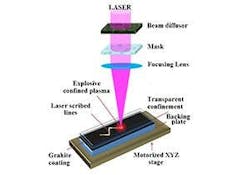Pulsed Nd:YAG laser writes nanodiamond formations into confined graphite film
Researchers at Purdue University (West Lafayette, IN) have created a technique called confined-pulse laser deposition (CPLD) to write formations of nanodiamonds into graphite.1 A pulsed Nd:YAG laser emitting at a 1064 nm wavelength ablates a thin layer of graphite confined under a transparent glass or quartz plate, creating a plasma that leads to diamond formation on the substrate below the graphite layer.
The writing can produce nanodiamond films and patterns with potential applications from biosensors to computer chips. Ultrafast lasers such as pico- and femtosecond lasers are not needed for this process, leading to relatively low-cost capital equipment.
Room temperature and pressure
"The biggest advantage is that you can selectively deposit nanodiamond on rigid surfaces without the high temperatures and pressures normally needed to produce synthetic diamond," say Gary Cheng, an associate professor of industrial engineering at Purdue. "We do this at room temperature and without a high temperature and pressure chamber, so this process could significantly lower the cost of making diamond. In addition, we realize a direct-writing technique that could selectively write nanodiamond in designed patterns."
Cheng notes that the resulting nanodiamond coating is very strong and could could be used for high-temperature sensors.
The researchers made the discovery while studying how to strengthen metals using a thin layer of graphite and a nanosecond-pulsing laser. A doctoral student noticed that the laser was either causing the graphite to disappear or turn semitransparent.
"The black coating of graphite was gone, but where did it go?" Cheng says. Subsequent research proved the graphite had turned into diamond. The research team confirmed that the structures are diamond using a variety of techniques including transmission electron microscopy, X-ray diffraction, and the measurement of electrical resistance.
A U.S. patent application has been filed on the concept through the Purdue Office of Technology Commercialization. More research is needed to commercialize the technique, Cheng says.
REFERENCE:
1. Qiong Nian et al., Scientific Reports (2014) doi:10.1038/srep06612
About the Author
John Wallace
Senior Technical Editor (1998-2022)
John Wallace was with Laser Focus World for nearly 25 years, retiring in late June 2022. He obtained a bachelor's degree in mechanical engineering and physics at Rutgers University and a master's in optical engineering at the University of Rochester. Before becoming an editor, John worked as an engineer at RCA, Exxon, Eastman Kodak, and GCA Corporation.

